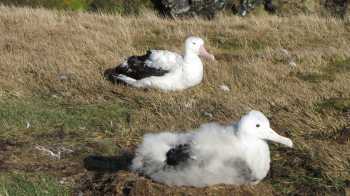Petra Quillfeldt (Vogelwarte Radolfzell, Max-Planck-Institut für Ornithologie, Radolfzell, Germany) and colleagues, writing this year in the Journal of Ornithology, have looked at extra-pair paternity in seabirds. In their review they report its occurrence in five species of albatross (Wandering Diomedea exulans, Waved Phoebastria irrorata, Black-browed Thalassarche melanophris, Grey-headed T. chrysostoma and Shy T. cauta) and one species of shearwater (Short-tailed Puffinus tenuirostris).
The paper's abstract follows:
"Seabirds are long-lived birds that exhibit very high levels of parental investment, and male parental care is indispensable. Seabirds have comparable breeding and life history parameters, being colonial, long-lived, and exhibiting little or no sex dimorphism. It is thought that these characteristics explain why seabirds exhibit a uniformly low level of extra-pair paternity. However, among the relatively few seabirds that have been studied to date, some regularly engage in extra-pair copulations, and the reasons for such inter-specific variability remain unclear. We here analyse paternity in a small sub-Antarctic seabird, the Thin-billed Prions [sic] Pachyptila belcheri, using species-specific microsatellites as genetic markers. We found that 7 of 34 chicks (21%) were not fathered by the male pair partner. This value is among the highest recorded for seabirds, and it now needs to be established if these result from forced copulations as suggested for some albatross species, or female cuckoldry."

Who's the daddy? Wandering Albatross and chick at Marion Island
Photograph by John Cooper
More reading:
Sexual shenanigans in the sub-Antarctic: Wandering Albatrosses engage in extra-pair copulations
Goings-on on Gough: extra-pair copulation in Sooty Albatrosses
Reference:
Quillfeldt, P., Masello, J.F. & Segelbacher, G. 2012. Extra-pair paternity in seabirds: a review and case study of Thin-billed Prions Pachyptila belcheri. Journal of Ornithology 153: 367-373.
John Cooper, ACAP Information Officer, 25 November 2012

 English
English  Français
Français  Español
Español